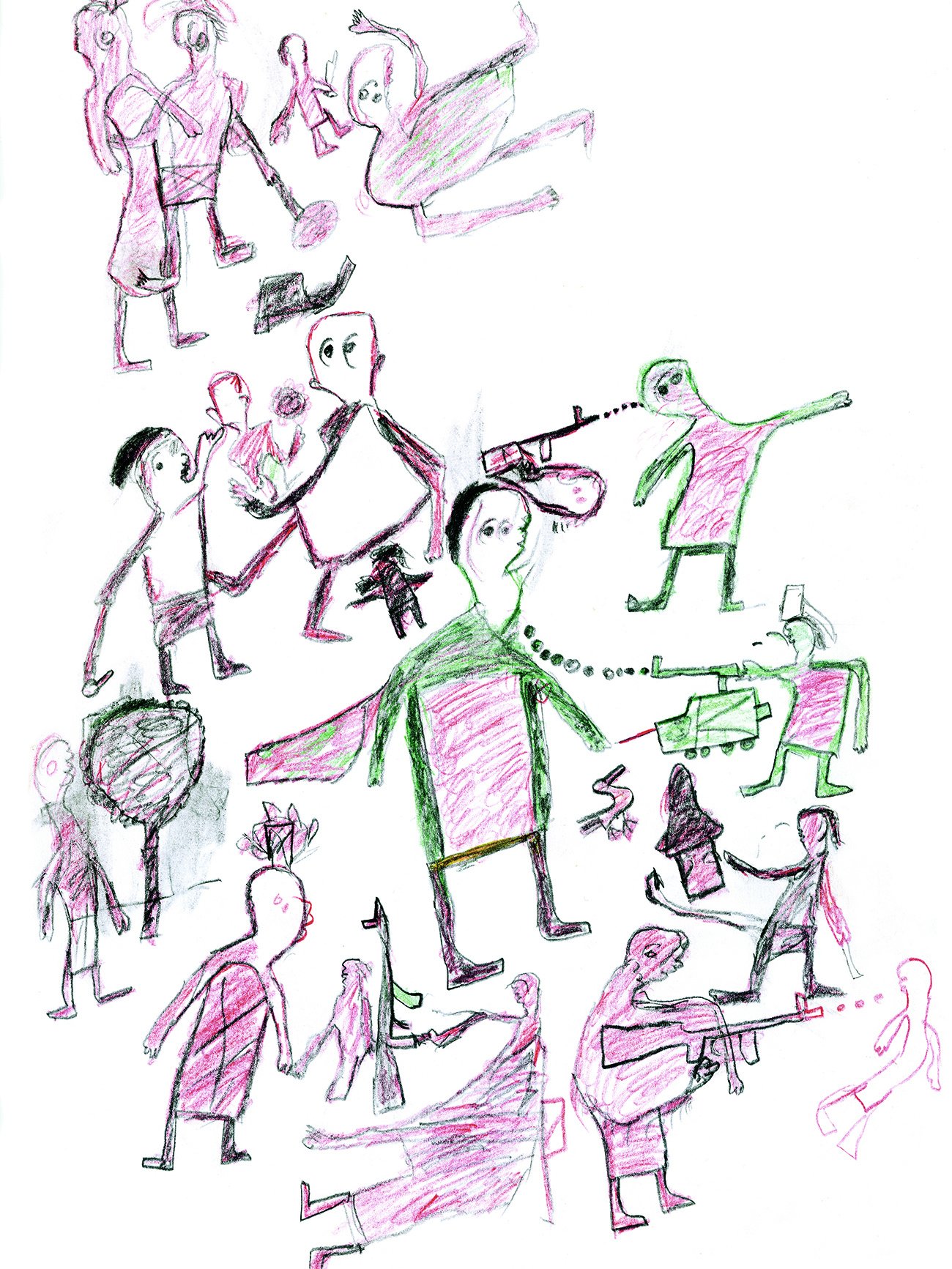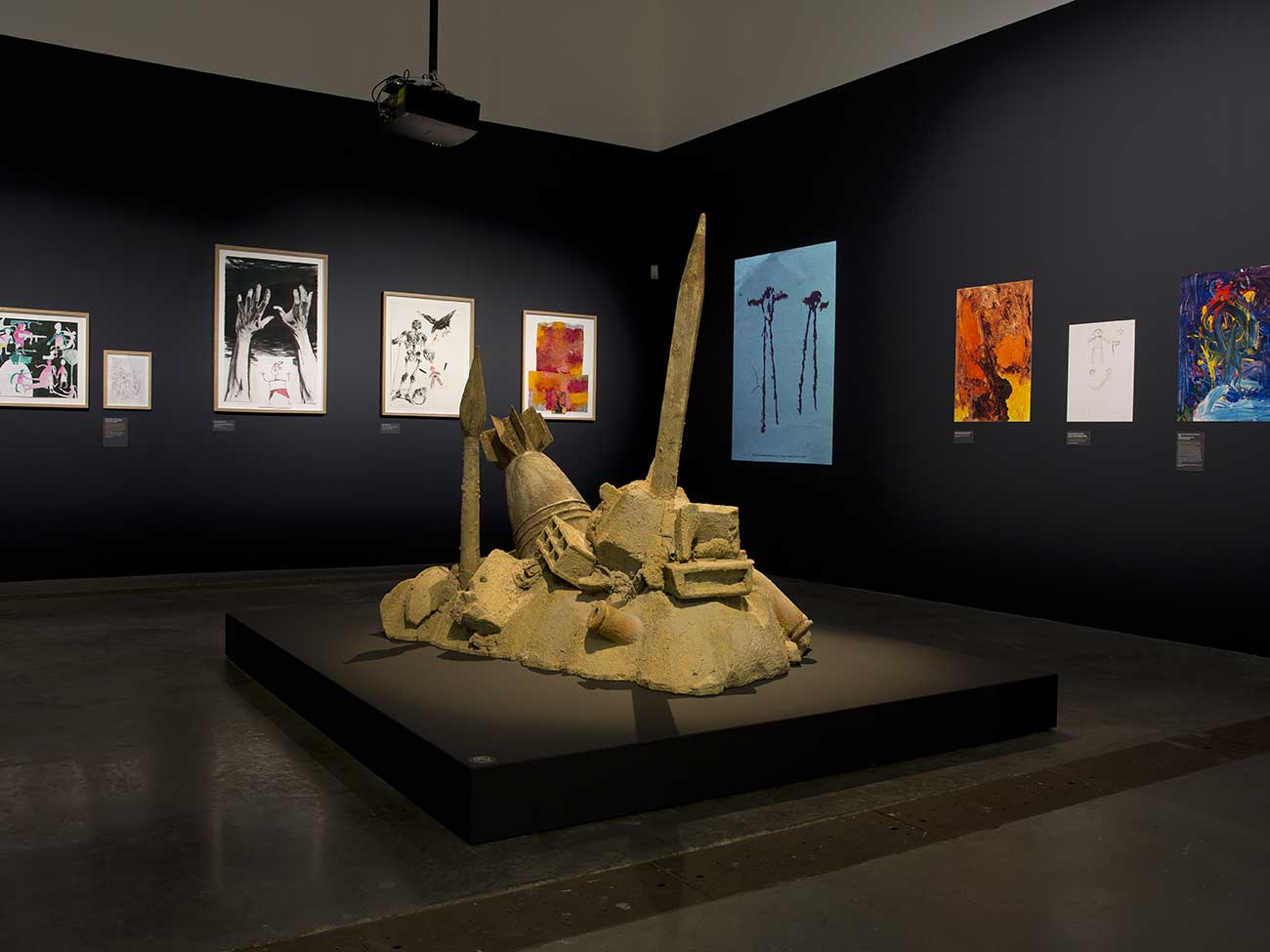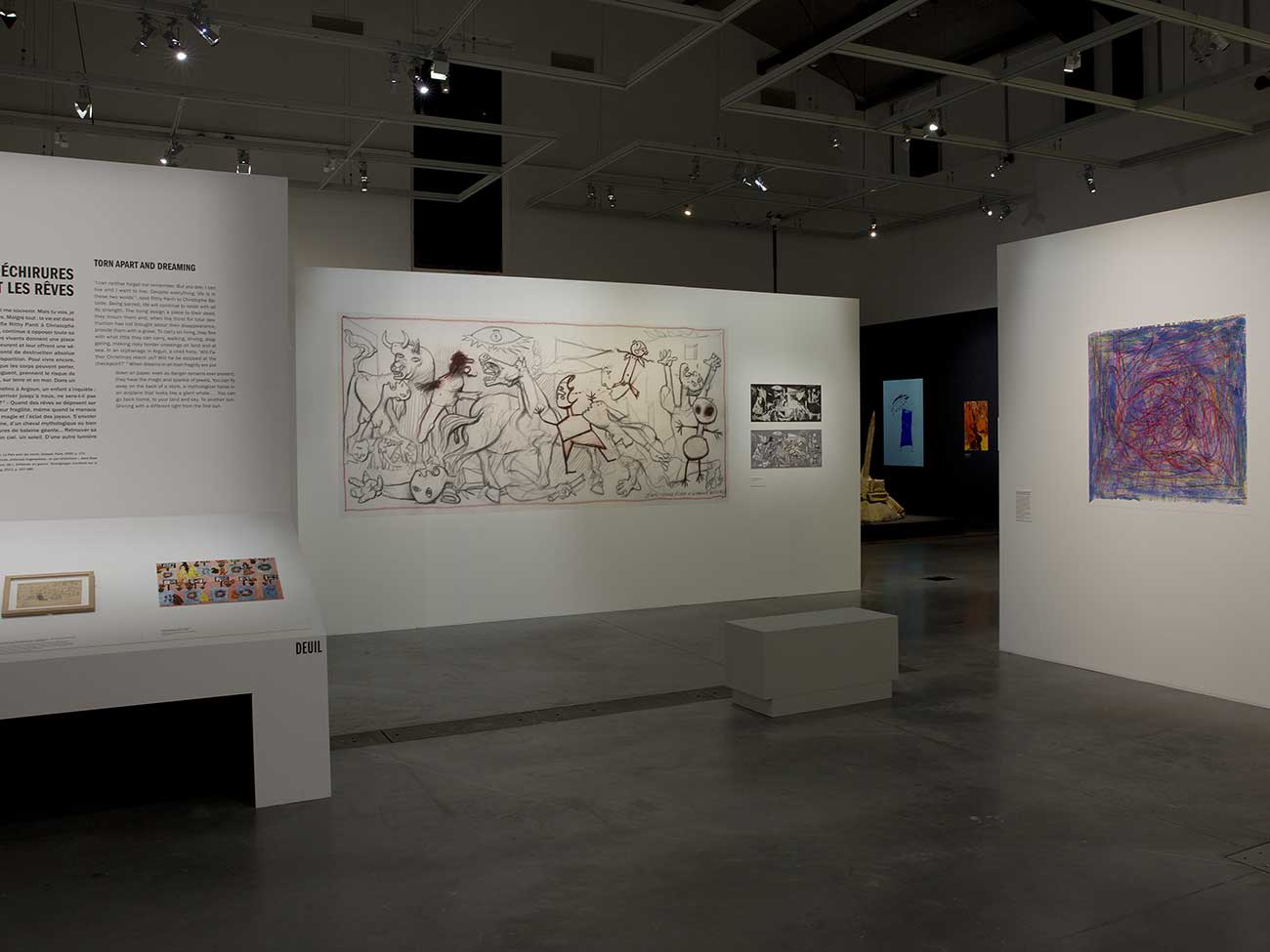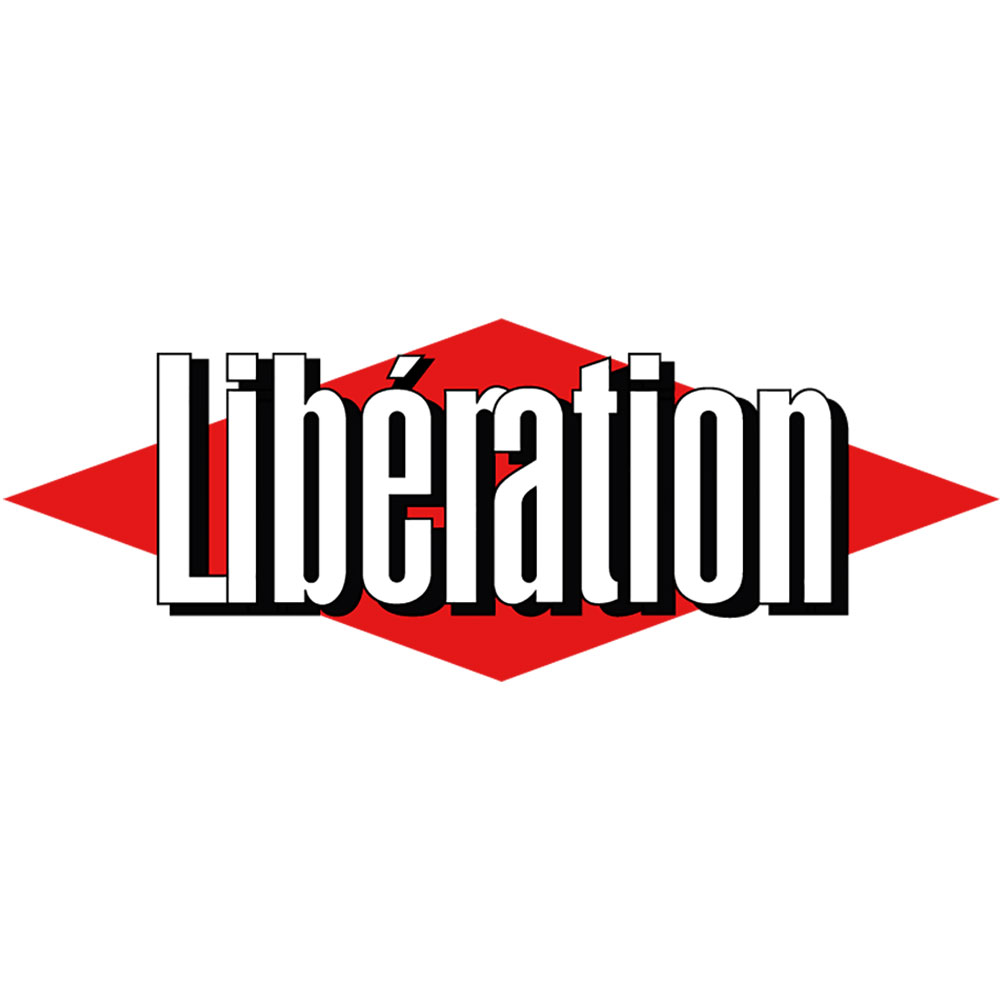Déflagrations
Children’s drawings and mass violence
Mucem, fort Saint-Jean—
Fort Saint-Jean Georges Henri Rivière Building (GHR) 320 m2
|
From Wednesday 19 May 2021 to Sunday 29 August 2021
Over 150 children's drawings made during times of war and mass violence... With Enki Bilal, associate artist
The exhibition, “Deflagrations”, is a tribute to a very singular creative process: that of children who, after having come into contact with death in situations of war or mass crimes, picked up coloured pencils to tell their stories.
In refugee camps, bombed cities, schools, health centres, and workshops, they created, traced, played, and also dreamed, taking possession of the universal and, at the same time, the infinitely personal language of graphic expression. They saw the rules that govern humankind destroyed, and yet, before us stands the full power of this process of drawing and within it, the seeds of resistance. Over the course of more than century, these images show us both sun and deflagration.
The exhibition presents over 150 drawings from museums, national and university libraries, international institutions and NGOs, as well as from the archives of psychiatrists, psychologists and war correspondents. Guests, artists and writers, alongside Françoise Héritier, offer as many echoes to these traces planted in history. Among them, we find Enki Bilal, a companion of the project since its inception and the artist associated with this exhibition.
Curation
Zérane S. Girardeau, curator, producer and artistic director, founder of Déflagrations
Association Déflagrations
With the participation of the artist Enki Bilal
Scenography
Renaud Perrin, scenographer
Géraldine Fohr, graphic designer
-
Interview with Zérane S. Girardeau, curator of the exhibition
-
Mucem (M.) How did this project come about?
Zérane S. Girardeau (Z.S.G) Long before this exhibition project, there was the shocking testimonies about the war in Syria: shocking images of repression; the panoply of prohibited weapons (cluster bombs, phosphorus incendiary bombs, barrels of TNT, sarin gas, etc); the bombing of civilian populations; schools, hospitals; and then, in this sea before us, the drowned bodies.
Of course, all the geopolitical chaos that we now know has set in, and with it, a feeling of powerlessness and hopelessness. Like everyone, I was aware of becoming accustomed to this long period of war that was raging, with the risk of feeling distanced, perhaps even of “derealization”... when barbarity ends up morphing into a distant background noise that disappears from the front page of our newspapers.”Deflagrations” began in a very instinctive way, by which I mean that it was first and foremost born out of a personal action and research: a need to keep one’s eyes open, not to see things as far away, not to be emotionally anaesthetised. This violence concerned me, and it was around the question of our relationship to violence and its representation that “Deflagrations” began to be written. The city of Strasbourg and the team from the André Malraux media library, who had expressed their interest in this research project, made it possible to create a first exhibition in 2017.
M. Do these children’s drawings make war more “sensitizing”?
Z.S.G They displace and sometimes disorientate our view of war and this view can be more sensitive. These drawings are intimate writings on fragments of the visual, emotional and physical memory of these children – singular and un-preplanned writings. Wounded, mutilated, tortured, raped, killed, forced to flee, subjected to deprivation, they are witnesses to the violence suffered by their loved ones, of the death of their loved ones – kidnapped, forcibly recruited and condemned to live in a warlike society, their experience of mass violence is total.
Their photographed and filmed faces arrive on our screens. But what is in those looks? What are their stories? Their fears? Their dreams? What is their intimate experience of violence and cruelty? As Cécile Hennion rightly says in the exhibition catalogue: “Have we kept a little of the hidden world of childhood inside us to understand what they have to say? [...] Would we know how to hear them?” In an attempt to approach this child’s eye view and singular gaze, the graphic expressions open up a field of incredible richness.
This act of figuration is both very personal and universal; with or with no learning, a child traces, draws, and this takes place across times, cultures and territories. By the simple fact of graphic and narrative repetitions, this shared language of lines and colours offers the possibility of linking personal stories hitherto scattered in different pages of history. Without denying all the historical and contextual specificities, this multiplicity of cohabiting narratives sheds new light on what is common to us, namely, anthropologically common: in the first instance, our shared vulnerability when death is boundless and physical and psychological integrity is threatened, when the ban on killing is lifted.
Even if reality is reconfigured in a very personal way in the children’s drawings (with erased, exaggerated, distorted elements), this non-verbal, “pre-verbal” language helps us to get closer to the intimate experience of violence. Contrary to an immediately and totally readable image, these drawings borrow from the real world as well as from the symbolic and the imaginary. Elements can therefore remain quite enigmatic. It is sometimes tiny details that will be the most significant elements. What is interesting is to observe how drawings can leave room for the imagination and mobilise our eyes and sensibilities in a different way on the subject of mass violence. Here, right next to the scene of fear, a flower, alone, stands high on its stem. There, mouths, sometimes arms, disappear from the silhouettes as if petrified, with a cry that is muffled. But the eyes that have seen are overdrawn. A yellow or red sun fixes the massacre, like a character in the scene. We can only touch and approach a story, a trace. The meaning, intimate as it is, remains the preserve of the child.
M. So, this exhibition is a form of homage to these children?
Z.S.G Yes, a homage to these children and their act of storytelling. While working on this documentation and discovering all its graphic, narrative richness, it was obvious that these drawings had to be shown. Exhibiting them also means giving them a place – a place that can lead us to better recognise their experiences of violence, their memories and their expressions in their own right. Fundamentally, giving them this evoked place – this recognition, isn’t this simply what we owe them?
Jean-Christophe Bailly speaks of the fundamental qualities of the image, “starting with its silent leap out of discourse and its power of deposition”. These words touch me particularly when I am in front of the children’s drawings, when I open an envelope addressed to me full of slightly crumpled sheets (because it is almost never drawing paper that is given to the children, but most often “poor” paper). It is impossible to miss one of the meanings of this word “deposition”: the complaint, heard and written down. Because these children, thrown into wars and mass crimes, have often seen the foundation of the human being ransacked by all the acts that are labelled as forbidden and criminal, even those that were still unthought of. Displaced, refugees, in a camp, in a health centre or elsewhere (but at least, most often, in a lull in the sky), they tell their stories with their pencils, then they give this paper marked with a message. They don’t bury it in the sand, they don’t hide it; more often not, they give it away. Yes, this personal act of deposition requires our gaze.
This act reminds us that if these children are victims, they are also witnesses and players who tell, record, show and take part in the memories and stories of societies.
Showing these drawings is perhaps also a glimpse of their power to call upon and strengthen our vigilance and resistance in the face of a rising discourse and its associated ideologies that construct figures of the “enemy”, stir up fears, and feed hatred – all these mechanisms that have often prefigured the pages of violence in history. Are these child cartoonists not scouts ... our scouts? And their drawings are warnings. Linda Lê delivers a very beautiful text in the catalogue: “Faced with darkness,” she writes, “[they] shed a different light on a confused world.”
M. What are the subject areas covered by this exhibition?
Z.S.G The first is thematic: wars and mass crimes, grouped under the non-academic heading of “mass violence”. These always correspond to a time of consent (of individuals, groups, states) to violence, sometimes to cruelty: a time of multiplication of death and destruction. This is our subject and the scope of our research. The violence and cruelty at work here can be qualified in certain cases by international criminal law as war crimes, crimes against humanity or genocide.
The second is temporal. Drawings from the First World War (from the Parisian collection “Le Vieux Montmartre” at the Musée Montmartre) are the oldest pieces in the corpus on display. Drawings of migrant children stranded in Libya, where the war rages, are among the most recent.
The third is geographic. The corpus with which we work is borderless. But Europe, the Middle East and Africa are particularly represented.
Exhaustiveness is, of course, out of reach in the temporal and geographical representation, when we think of the intensity of the violence that has swept over the world in a century, as well as, very concretely, because we are working on fragile, poorly preserved - and even more so in times of war - traces of this lacunar fact.
Constraints related to the exhibition space led us to discard numerous drawings. The many drawings on display, however, take us through very different times, cultures and territories.
M. These children’s drawings, what do they tell?
Z.S.G First of all, they tell us about singular lives... and unique, irreducible experiences. There is far too much uniqueness in the person of each child, far too many contextual, historical, social and cultural multiplicities to synthesise such an incredibly vast and complex subject. We show a tiny constellation of just over 150 drawings that span a century. Within this constellation, drawings and narratives come together, suggesting thematic figures and ideas. They are open suggestions, leaving room for the imagination. The wish is to avoid making the drawings dependent on ideas or concepts that predate them, and not to ascribe an interpretation to them.
We can see monster figures, incarnation of a diabolical enemy, and heroic figures – real or fantasy. We can see all the terror when we are before a sky of fire, the bombings that invade the drawings of the Spanish War up to Syria and its exploding barrels. We come close to the word “deflagration” when everything explodes and implodes at the same time, giving way to a magma of fire and emptiness. Silhouettes, in a few strokes, silently express fear. One of them is accompanied by the gaze of Sonia Wieder-Atherton and her cello, others by the technique of Ernest Pignon Ernest or Vladimir Velickovic...
Instances of looting, murder and desecration are as if written on the retinas of the children. This inscription is given back to us by the lines of the drawings – far removed from photographic snapshots, which would be unbearable to be looked at in cases of tortured bodies. Here, the drawing allows the eye to enter the scene and approach the intimate experience of the worst violence.And then, because life must be saved, it is flight and exile that invade the sheets of paper. Fleeing, that “dispossession without recourse,” of which Etel Adnan speaks, “when ‘the other’, someone or something, takes possession of what you abandon and what you leave behind.” Then, in the drawings, the silhouettes, loaded with what they can carry, walk, roll, sail, and try to cross borders.
Always, in this crossing at the heart of the children’s stories, something insists: life. This act of children, that of drawing, is first of all an act of life, of connection, of care sometimes, of a story given, shared, an act won over death and destruction. While human existence has been damaged and destroyed, they have made an act, acts of resistance, in the image of suns and flowers and drawn dreams... which also resist.
M. How were these drawings collected?
Z.S.G The identification of the drawings is always a surprising story of research mixed with bifurcations, coincidences and discussions. But it is first of all a great web of readings, meetings, things said in trust, and rallying of efforts over a long period of time, which allowed us to move forward with such a vast subject.
Beyond a few specific cases, I distinguish several types of sources:
Museum and archival sources: in most cases, these are drawings about old conflicts (the First and Second World Wars, the Spanish Civil War, etc) or fairly recent sources which were given archival status quite recently (I am thinking, for example, of the drawings of Darfur which the NGOs Waging Peace and Human Rights Watch have deposited in archival collections). These protected archival funds, now in the hands of institutions, have sometimes been used to support publications by historians (for example, on the children of Germany and the territories annexed by the Nazis, on children in Paris during the First World War, and on the children of the Spanish Civil War). There are also the archives of several associations and NGOs on past missions (such as Enfants Réfugiés du Monde) and lastly, personal archives - for example the collection of war correspondent photographer Patrick Chauvel, which includes drawings by Chechen children from the Second Chechen War, documents that were photographed when a film was made in 2000.
The second type of sources were editorial, mainly dated between 1960 and 2000 – artists committed to a people and their cause who carried out editorial projects after having had children, most often displaced or refugees, draw (in the contexts of wars in Algeria, Palestine and Western Sahara). These drawings born under the impulse of artists often stand out pictorially. I am thinking here of the drawings collected by the artists Seta Manoukian, Mona Saudi and Kamal Boullata. NGOs have also supported editorial projects from the 1980s to the 1990s. In both cases, these are publications dedicated solely to a conflict with the objective of witnessing and raising awareness, including sometimes on clinical work in humanitarian situations. In the majority of these cases, most of the originals have disappeared. The work then consists of enhancing the value of these editorial reproductions.
And then, of course, the most contemporary part of the sources were identified thanks to international institutions (UNICEF, UNHCR, project partners) and NGOs (Médecins Sans Frontières, SOS Children’s Villages, Triangle Génération Humanitaire, Human Rights Watch, Solinfo, Alwane, etc). It is a very beautiful chain that was mobilised (and continues to be so), even in the refugee camps and health centres. Without doubt, there was the support and trust given and gathered around the common objective: to show these drawings. It is a question of documenting these sources of contemporary conflicts in the best possible way, with the necessary protection of children and their identity. Weaving these links and taking care of the implications and all the help provided was a long process, of course, but an exciting one.
M. Among all these drawings, are there any stories or journeys that particularly appealed to you?
Z.S.G Many... this is the very reason why it is difficult to envisage suspending such research and not continuing to safeguard these images.
I immediately think of the drawing of an Eritrean boy: first a refugee in Ethiopia, he set off for Europe at the age of 12 after the death of his father. Upon his arrival in Libya in 2017, he was sold to human traffickers. When he was released from their illegal prisons, he tried to cross the Mediterranean in the summer of 2019. In October, in a detention centre for migrants, he drew the shipwreck (130 dead). Around the boat, all the little silhouettes with their arms raised still resist, and in the centre, the scene that never leaves him: a father holding his two babies in his arms, who finds it impossible to let go of his children to swim; he keeps them with him and together all three sink. The MSF medical team sent me this drawing one evening at midnight; this extremely precise image and its story have never let go of me. I made a promise that this drawing would be shown.I would also like to mention the drawing of Haidar, 11 years old, who drew The Barrels in 2012 in Raqqa in Syria: three green helicopters throw black explosive barrels at a city with houses of all colours, in a blue Mediterranean sky. When the Alwane NGO shared this drawing with me, we knew nothing of what had become of Haidar. Several years later we would learn that his house was bombed by the regime. Haidar died in the bombing with a brother, a sister, his pregnant mother, an uncle and an aunt together with their two children. His father and one of his brothers were not at home and survived. The drawing of Haidar’s “barrels” is there as a last drawing – a clamour that has not disappeared.
M.
Artists such as Enki Bilal have accompanied this project. How do they participate in the exhibition? Z.S.G Enki Bilal has been onside with the project since the beginning. When he saw the first drawings that had been collected, he offered his help, his presence, proposing that he and other artists offer an answer to these drawings. He has been accompanying “Déflagrations” for several years now; his presence and confidence have been precious, as have those of the anthropologist Françoise Héritier and the philosopher Pierre Hassner, as well as the writer Linda Lê, the artist Sonia Wieder-Atherton, the historian Catherine Gousseff, the lawyers Monique Chemillier-Gendreau and Olivier Bercault, the magistrate Bruno Cotte, the war correspondents Rémy Ourdan and Cécile Hennion, and the director Guy Baudon who showed me the drawings of Spain by Alfred and Françoise Brauner over twenty years ago...
Observing the act of the child who most often gives his drawing and thus calls for a personal conversation, I proposed to artists, writers, researchers and war correspondents to accompany a child’s drawing by offering them an answer. These acts are as many highlights, echoes and acknowledgements given to “traces” beyond time. Only a few of these participations/conversations are present in the exhibition.
We see Françoise Héritier, who was the patron of the project until her death in 2017, in a masterful analysis of a drawing by a child from Darfur. I have never seen anyone take possession of these children’s drawings as she did; all the details were scrutinised, questioned and commented on. She had the generosity of transmission that makes children as well as adults receive her filmed analysis – both simple and brilliant at the same time. Born in 1933, she remembered her terror as a child during the Second World War, a terror that she deciphered in the signs drawn by the children.
Enki Bilal, the artist sponsor of “Deflagrations”, has made three different contributions in the exhibition. He responds to the drawing of a Tutsi child from Rwanda, who witnessed the murder of his father. In the same space, he has imagined a ground installation, Battlefield with Weapons of War, the bearers of devastation. Finally, he created an interpretation-montage based on Pablo Picasso’s Guernica. It is entitled Six Artists to Translate Horror, and brings together: “The artist Pablo P. who shows the bombed city; the anonymous artist A who shows the executed father; the anonymous artist B who shows the fear of the tetanized man; the anonymous artist C who shows the angel taking flight; and the anonymous artist D who shows the exorbitant gaze... The sixth and last one, the artist Enki B., who brings the five others together.”
He adds: “But of all of them, only the four anonymous child artists know what they are talking about, because only they have experienced the moment. Thanks to them [...], the war against the men who make war goes on.”This idea around the inversion of the conveying process recalls the sentence pronounced by the author of this universal work on the war that is Guernica (where for the first time, the air force systematically massacred a civilian population). Pablo Picasso had a real attraction for children’s drawings. After the war, visiting an exhibition of children’s drawings organised in Paris by the British Council, he was heard to declare: “When I was their age, I used to draw like Raphael, but it took me a lifetime to learn to draw like them.”
Downloads
Dossier enseignant Déflagrations .pdfPartners and sponsors
With the support of Babyzen SAS, mécène de l'enfance au Mucem
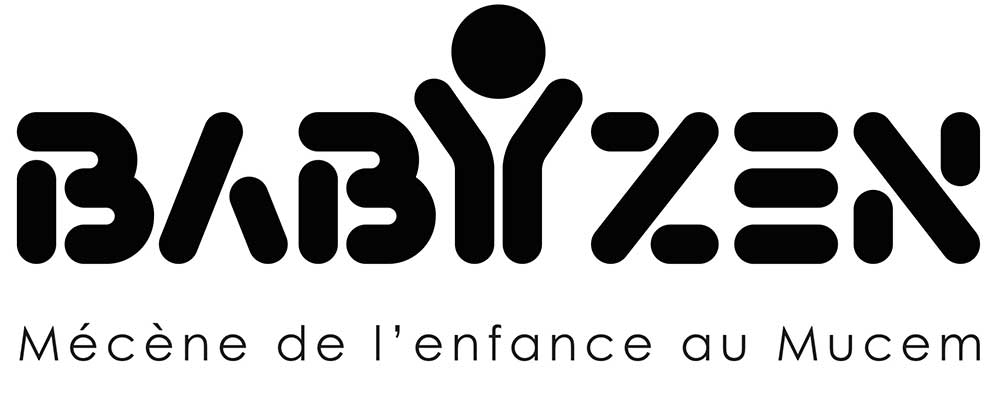
In partnership with Libération
